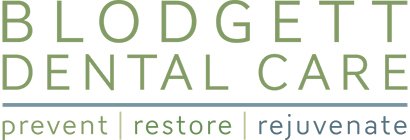Should You Use a Soft or Hard Toothbrush?
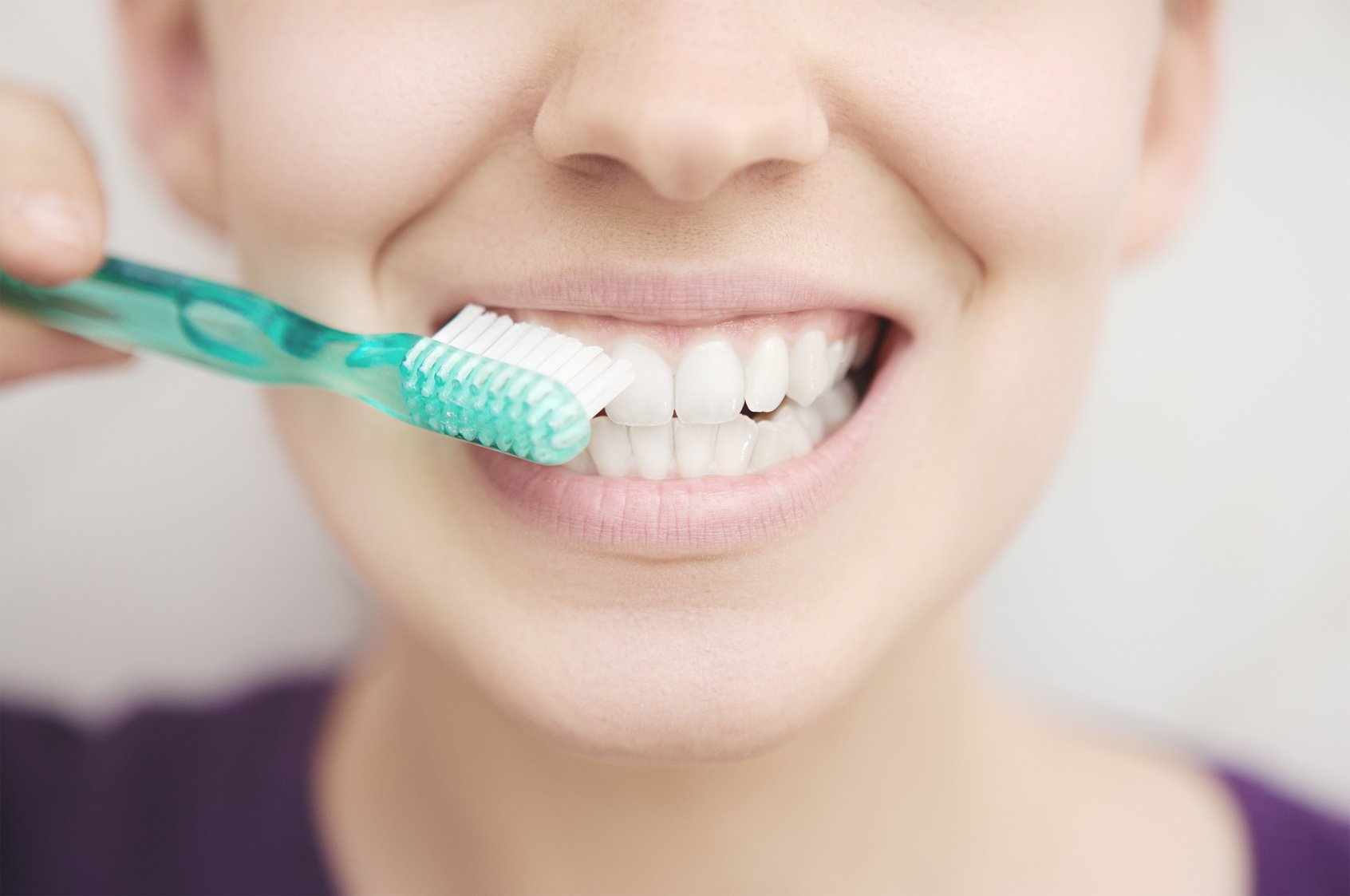
It can be bewildering trying to choose the right toothbrush. There are just too many options and too many competing opinions by brush manufacturers and other experts. One of the hardest (no pun intended) decisions to make can be whether you need a brush with hard or soft bristles.
Today I’ll talk to you about the differences between hard and soft toothbrushes (and give my recommendation), as well as provide a few simple tips to help you choose the right toothbrush for you.
What’s the Difference Between a Hard and Soft Toothbrush?
When people ask about a hard or soft toothbrush, they’re referring to the bristles used to clean your teeth. Hard bristles are stiffer than soft bristles. In theory, they’re designed to be better at removing stains, plaque, and stubborn bits of food.
So, should you use a soft or hard toothbrush?
Choose a Soft Toothbrush
Everyone should use a soft toothbrush. But it’s not for the reason you might think. Many people believe that hard bristles can wear away at your tooth enamel. They can, but sugary and acidic foods, like soda pop, fruit juice, and candy do much more damage to your tooth enamel than a hard-bristled toothbrush.
Instead, it’s your gums you should be worried about if you use a hard toothbrush. Most people brush too hard. And brushing too hard, especially with a hard-bristled toothbrush can damage sensitive gum tissue, especially around the gumline.
Think about sweeping beautiful hardwood floors. A broom has bristles that are designed to brush away dust without damaging the floor. However, if you replaced the normal bristles with steel wire, it would still sweep your floor, but damage it at the same time. Similarly, hard toothbrushes are too stiff– just like a broom with steel wire bristles! Yes, they can get your teeth clean. But they can also do damage to the enamel, root surfaces and gum tissue.
When it comes to your teeth, stick to a soft-bristled toothbrush. Save the hard-bristled brushes for cleaning around the house or scrubbing your bicycle chain, but keep them away from your mouth! Here’s a couple fun ideas for how to reuse your old or hard-bristled toothbrushes.
Natural or Synthetic Bristles?
The vast majority of toothbrushes on the market have synthetic (i.e. nylon plastic) bristles. Recently, however, brushes with natural bristles, usually made from plant or wood fiber have become more popular. These brushes are sometimes marketed as biodegradable or boast other benefits.
Either is fine– as long as the brush you choose has soft bristles. The real issue, however, is how hard you brush. Even a soft bristled brush can do damage if you brush too hard.
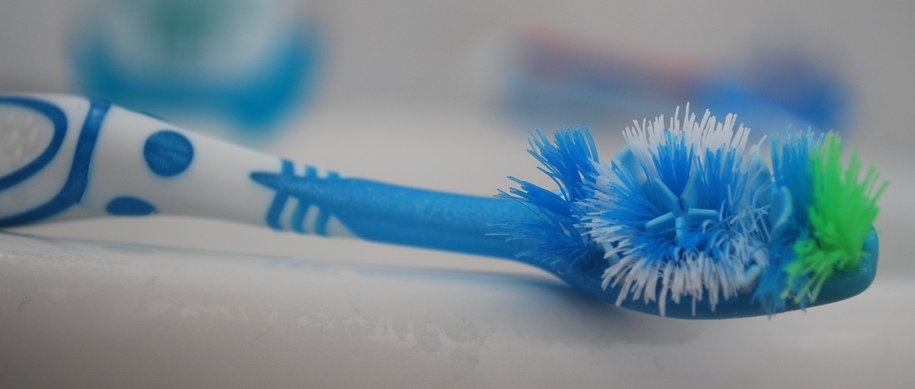
If the bristles on your toothbrush look like those in the picture above, you’re brushing too hard!
Heads and Handles?
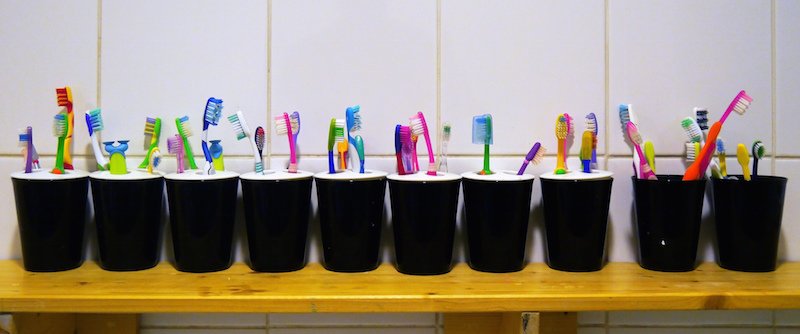
When you’re choosing a toothbrush, you’ll find an almost infinite combination of brush head and handle styles.
Rather than spend too much time talking about each of them, here’s what I think you need to know:
They don’t matter that much.
Look for a brush handle that’s comfortable and easy to hold. Angled or bent handles can make it easier to reach some parts of your mouth, but they aren’t necessary. A straight-handled brush with a small head is just as easy to use and just as effective.
As for brush heads, the most important factor should be size. In general, for adults, a toothbrush’s head shouldn’t be longer than a quarter. A brush head that’s too big can be hard to reach into the back of your mouth. That just makes cleaning all of your molars harder than necessary..
Different bristle patterns and head shapes can have different benefits. Personally, I like Oral B’s floss-action toothbrush heads, especially on their electric toothbrushes– but I’ll talk more about that soon.
Electric or Manual?
So that brings us to a big question many people have, “Should I use a traditional manual toothbrush or a fancy electric model?”
I’m a big fan of electric toothbrushes, but only when they’re used properly. Electric toothbrushes are very powerful. It’s very easy to brush too hard and irritate your gums, even when using a soft brush head.
Here’s my tip: Hold your electric toothbrush with your fingertips. This will help keep you from putting too much pressure on your teeth and gums while you’re brushing!
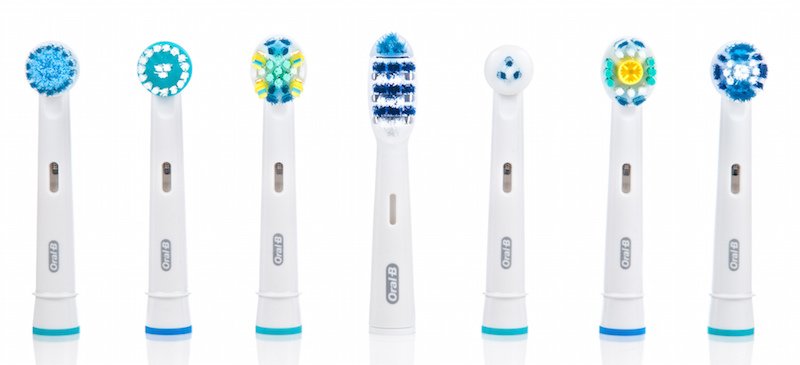
Oral B Electric Toothbrush Heads: My personal favorite: floss-action head, third from the left.
As for which brand to choose, I recommend Oral B’s electric brushes from the Precision Series. There are a variety of head options, but I particularly like the floss-action heads. Speaking of electric brush heads, don’t forget to change them frequently! Some heads change color as they wear out.
Check your brush’s instructions to make sure you know when your heads need replacing. And even though they’re a bit cheaper and they may fit your brush, don’t buy generic or knock-off brush heads. You can’t be sure they’re the same quality or stiffness as those made by your brush’s manufacturer.
One of my favorite features on many electric toothbrushes is a vibration or light that lets you know when you’ve brushed for a certain amount of time. This can be handy if you’re not sure that you’ve spent enough time brushing!
Other popular brands of electric toothbrushes to consider include Sonicare and Waterpik. Just make sure your electric brush has the American Dental Association’s ADA seal of acceptance.
Which Toothbrush is Best?
So I’ve written a lot today about hard and soft bristles, electric and manual toothbrushes. Are you still wondering which toothbrush is best?
If you are, don’t stress out.
 A good toothbrush is one that is ADA accepted with soft bristles, a small head, and a handle that’s easy to hold.
A good toothbrush is one that is ADA accepted with soft bristles, a small head, and a handle that’s easy to hold.
What makes a good toothbrush a great toothbrush is using it consistently as part of your home dental care in the fashion recommended by your dentist and dental hygienist. Brush twice a day with toothpaste (I like Toms of Maine, which is free of Sodium Laurel Sulfate) and floss thoroughly once a day.
Avoid using mouthwash, but consider oil pulling as an additional treatment or brew up some organic green tea, let it cool and swish with that. It has been clinically proven that swishing with green tea reduces inflammation better than common mouthwashes!
And remember to replace your toothbrush every 4 months or even sooner if the bristles start to look worn out and frayed (don’t forget that this can also be a sign that you’re brushing too hard).
If you still have questions about choosing a toothbrush or caring for your teeth, get in touch with us at Blodgett Dental Care. Our preventive dental care is focused on your whole-body health! If you’re not already one of our patients, ask about our new patient specials.
Photo Credits: Groume, Stuartpilbrow, William Warby, Julie Monday, Emdot
Do you have questions? We have answers! Go to ASK BDC to learn more.
Read Also
Mouthwash Is Bad For You: 4 Better Alternatives
Mouthwash Is Bad For You: 4 Better Alternatives [Updated 5/25/2024]Did you know that Listerine was once marketed as a surgical antiseptic and powerful floor cleaner? What you don’t know about mouthwash might surprise you. Especially when it comes to your dental...
Blodgett Dental Care Embodies Humanistic Dentistry
Blodgett Dental Care Embodies Humanistic Dentistry Dentistry has become “green washed” with terms that are now meaningless. Practically every dental practice is using terms such as “holistic”, “biological”, “functional”, and “integrative” to capture clicks with their...
Toxic Tuesday: Wisdom Tooth Extractions and Breast Cancer
The Connection Between Wisdom Tooth Extractions and Breast Cancer Wisdom teeth are extracted in the United States at a rate of more than 10 million every year! But what are the consequences to your health when the extraction sites do not heal properly? Today’s story...
